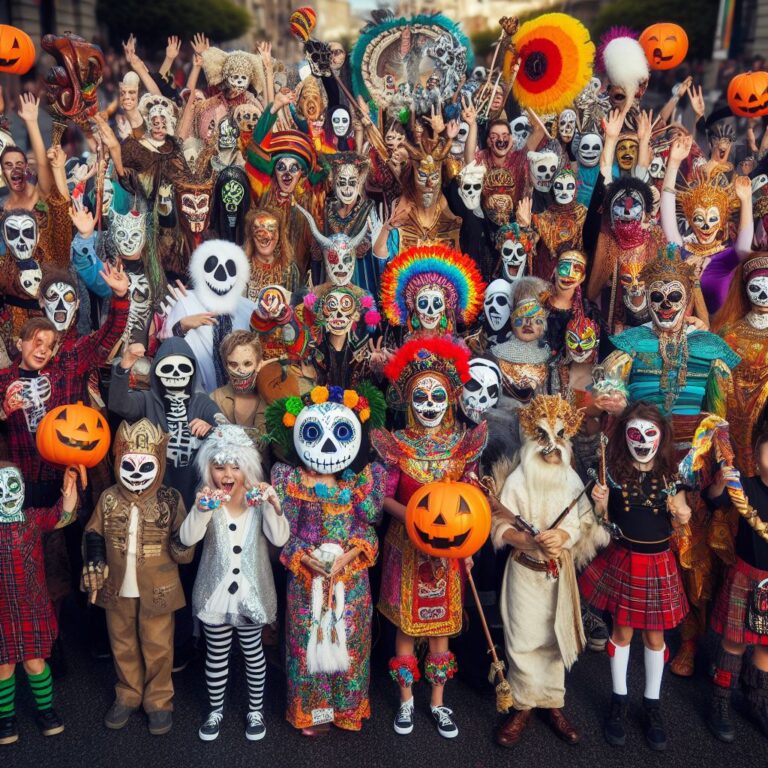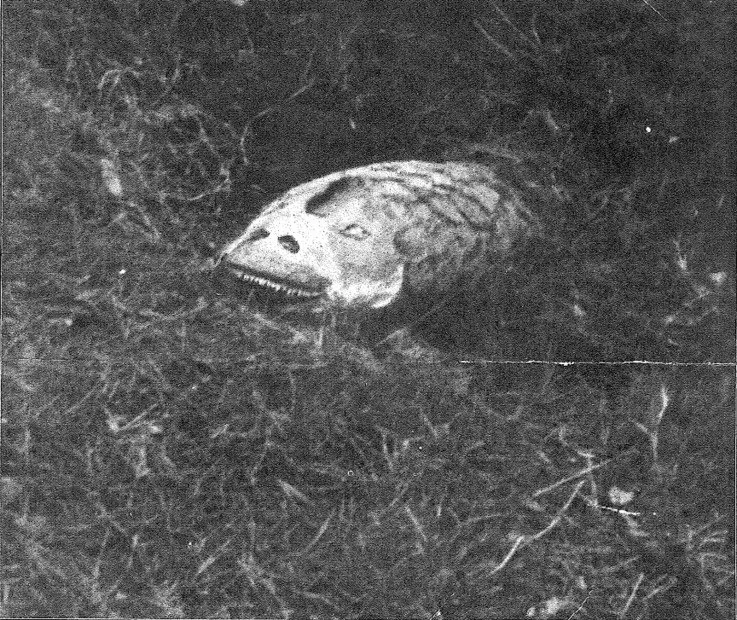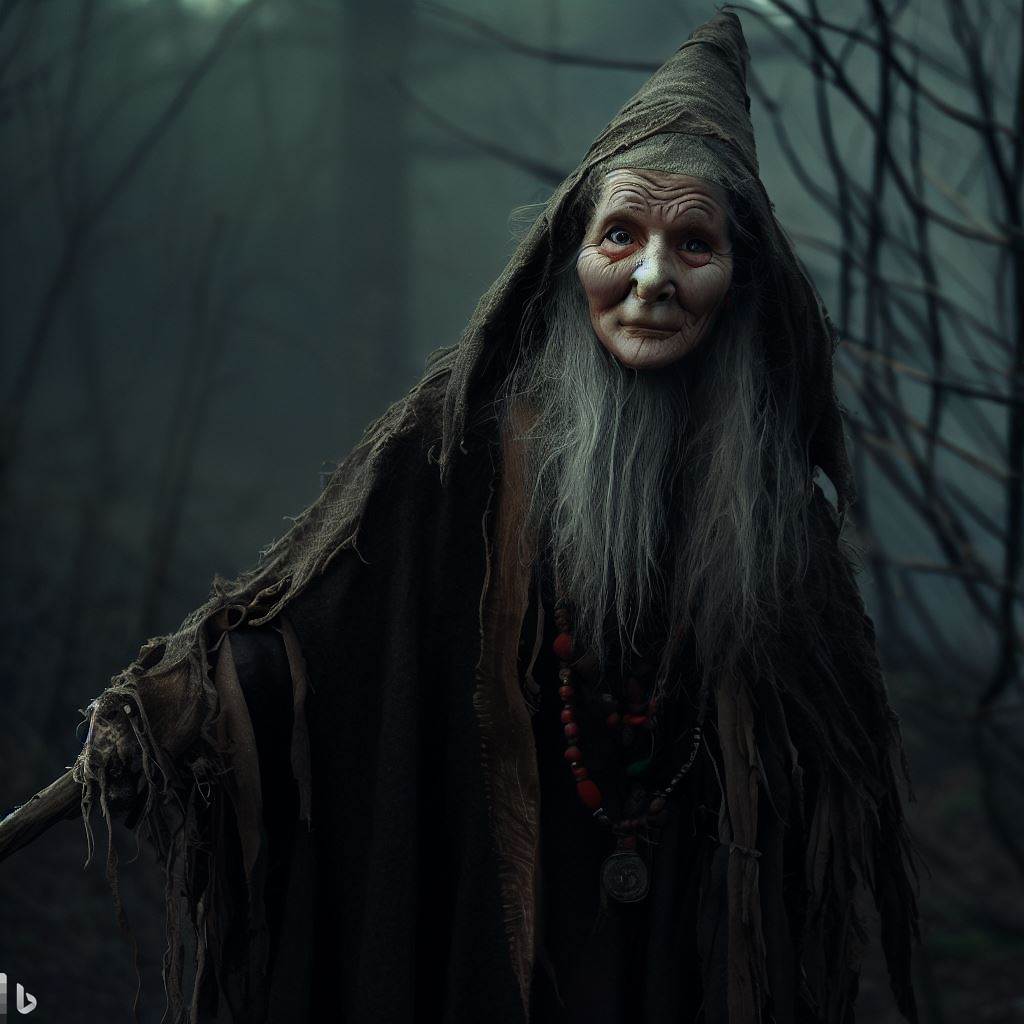
Baba Yaga is one of the most intriguing and complex figures in Slavic folklore and mythology. She appears as an old crone living deep in the forest in a magical hut.
Baba Yaga is portrayed as a dangerous witch in many ancient folktales, where she tests heroes with impossible tasks.
However, she also frequently aids and rewards worthy heroes who exhibit courage and virtue. Her origins are ancient and trace back to Slavic pagan beliefs.
Over centuries of oral tradition, Baba Yaga evolved into a mysterious, dual-natured character who straddles the line between good and evil.
This article will explore the key details about this iconic Slavic folklore figure.
RELATED: See why Baba Yaga made the list of the most terrifying mythical creatures.
Who is Baba Yaga?
Baba Yaga is usually depicted in folktales as a cannibalistic old hag with iron teeth. She lives in a hut that stands on chicken legs and can spin around to disorient visitors.
Her disheveled hair is wild, and her long nose and bony legs give her an ugliness befitting her fearsome magical powers.
Baba Yaga has mastery over the elements and forces of nature. She is able to fly around in a large mortar, using a pestle to steer.
Her command of black magic allows her to place curses on enemies. She also has power over spirits and other creatures who dwell in the depths of the forest where she makes her home.
Her origins likely stem from ancient Slavic pagan associations between old age, women, and dark witchcraft.
Over time, she emerged as a key antagonist and magical helper figure in countless Slavic folktales.
Baba Yaga’s character displays a dual symbolism. On one hand, she embodies the menacing and dangerous aspects of old age, death, the wilderness, and the unknown.
Yet she also possesses wisdom and helps heroes who prove themselves virtuous, resourceful, or worthy of magical gifts.
This morally ambiguous duality makes Baba Yaga a particularly fascinating and mysterious character. She is more complex than a standard evil villain or benign fairy godmother.
Baba Yaga’s Hut

One of the most iconic parts of Baba Yaga’s depiction in folktales is her magical hut. It stands deep in the forest and is surrounded by a fence made of human bones with skull lanterns.
According to legends, the hut spins around on its chicken legs to disorient any visitors.
The chicken legs enable the hut to move about the forest at Baba Yaga’s command. Some stories say it can even step over the forest floor without uprooting the trees.
The hut’s ability to move reflects Baba Yaga’s own transience and liminal status as a figure who straddles many realms.
She is neither fully tame nor wild, neither living nor dead. Her hut’s associations with bones and death also symbolize her menacing side. Yet the hut also represents shelter, and she welcomes worthy visitors.
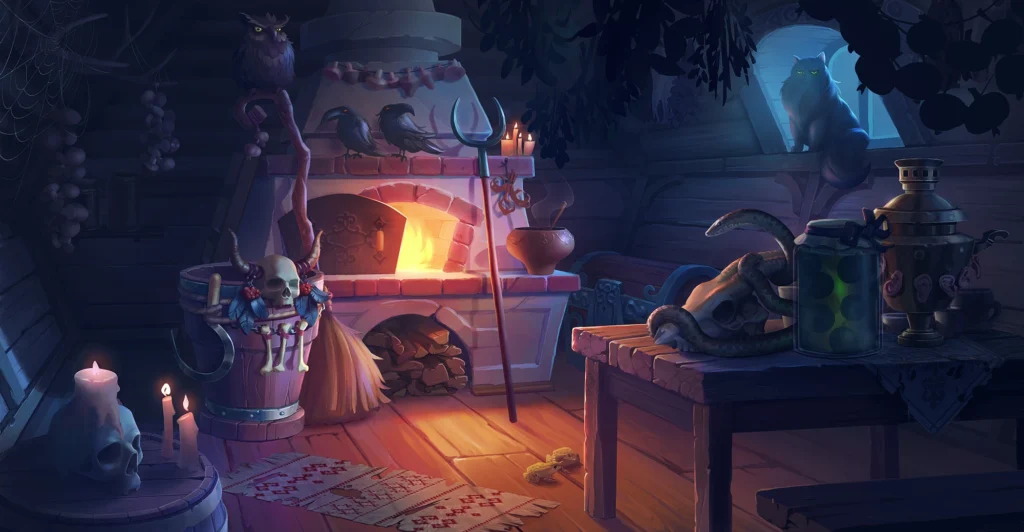
Image credits:deviantart.com
Baba Yaga’s Powers
Baba Yaga possesses many magical powers and abilities. She is able to fly through the air on a giant mortar, which she steers with a pestle.
This mode of transportation sets her apart from typical humans and even witches. Baba Yaga also exhibits mastery over nature and the elements. She is able to command the forces of the forest, including animals and spirits.
Her magic allows her to curse her enemies and place hexes or obstacles in the path of travelers and heroes she deems unworthy.
However, her powers are not just dark and ominous. Baba Yaga also uses her magic positively at times to reward, heal, or protect people who exhibit courage, wisdom, virtue, or kindness even in the face of her tests.
Some folktales speak of her giving advice, magical boons, or other aid to worthy heroes who visit her hut. Her dual powers reflect her ambiguous and complex moral symbolism.
Baba Yaga’s Role in Folktales
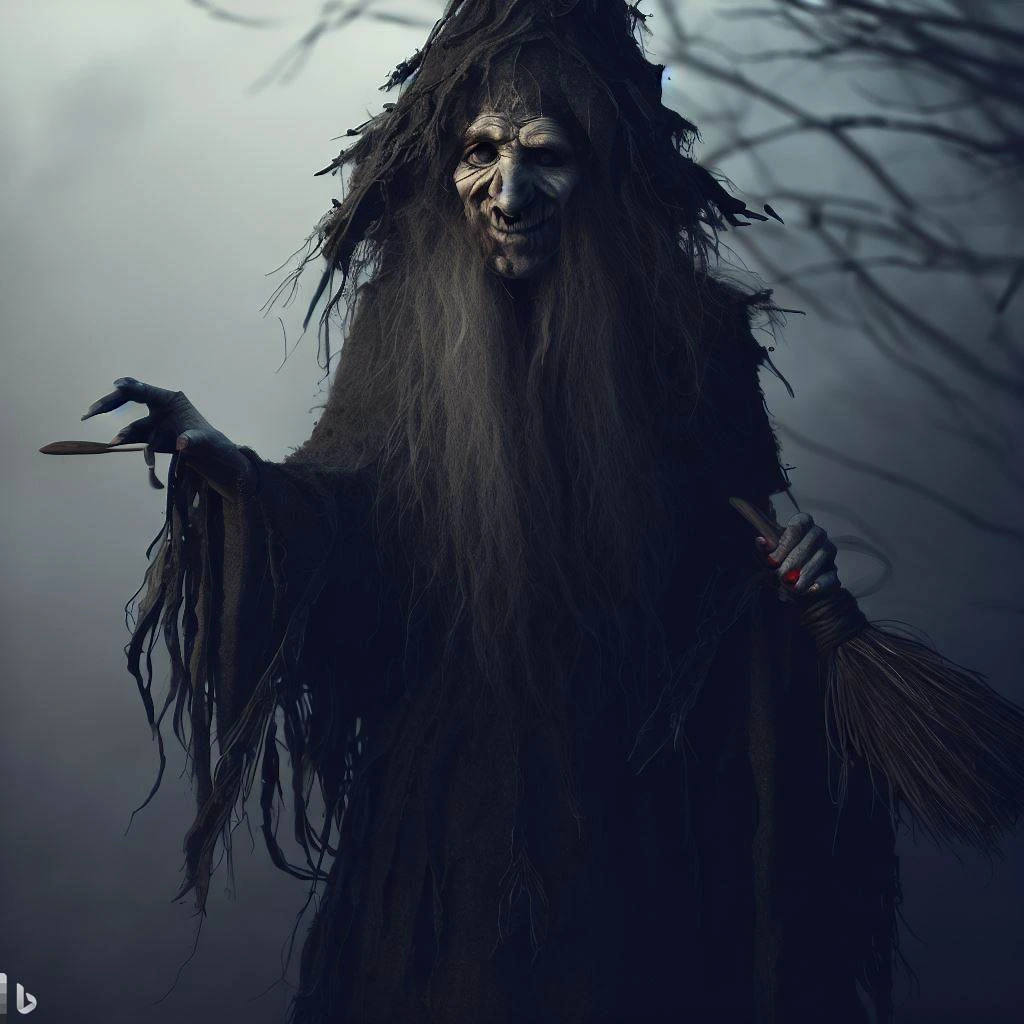
Baba Yaga’s most famous role in Slavic oral tradition is as a magical antagonist who tests heroes in folktales. She often appears without warning to confront the protagonist and sets them an impossible task.
Stories and Themes Involving Baba Yaga
Baba Yaga appears in many famous folk tales that feature her as a donor or a villain or both. Some examples are:
- Vasilisa the Beautiful: A young girl named Vasilisa is sent by her wicked stepmother and stepsisters to fetch fire from Baba Yaga’s hut.
There, she meets the witch who gives her impossible tasks to do before she can get the fire. With the help of a magic doll given by her mother, Vasilisa completes the tasks and escapes from Baba Yaga with a skull-lantern that burns her enemies to ashes. - The Death of Koschei the Deathless: A prince named Ivan Tsarevich rescues a princess named Marya Morevna from a sorcerer named Koschei the Deathless who keeps her captive.
On his way back, he meets Baba Yaga who tells him how to kill Koschei by destroying his soul that is hidden inside an egg inside a duck inside a hare inside an iron chest buried under an oak tree on an island. - The Frog Princess: A tsar orders his three sons to shoot arrows into the air and marry whoever finds them. The youngest son named Ivan shoots his arrow into a swamp where it is found by a frog who turns out to be a princess named Vasilisa the Wise under a curse by Baba Yaga’s son.
Ivan tries to break the curse by burning the frog skin but only makes things worse. He then goes on a quest to find his wife who has been taken by Baba Yaga’s son to his mother’s hut. - The Firebird: A tsar sends his three sons to catch a firebird that steals his golden apples. The youngest son named Ivan catches a feather of the firebird but fails to capture it.
He then goes on a quest to find the firebird with the help of a magic horse and encounters Baba Yaga along the way. She tries to eat him but he tricks her and escapes with her magic items. - Babushka Baba Yaga: Living alone and lonely in the woods because of the terrible stories told about her, Baba Yaga yearns for a grandchild to love and sets out to adopt a family of her own, in a fable about not judging individuals by their appearance alone.
These stories have common motifs and patterns that appear in them. Some of them are:
- The quest for a magical object or person
- The encounter with a talking animal or bird
- The test of courage or cleverness
- The escape from captivity or death
- The transformation or revelation
These stories also convey main themes and messages that reflect the values and beliefs of the Slavic culture. Some of them are:
- The initiation into adulthood
- The balance between good and evil
- The power of nature
- The role of fate and free will
- The value of kindness and gratitud
Modern Depictions and Adaptations
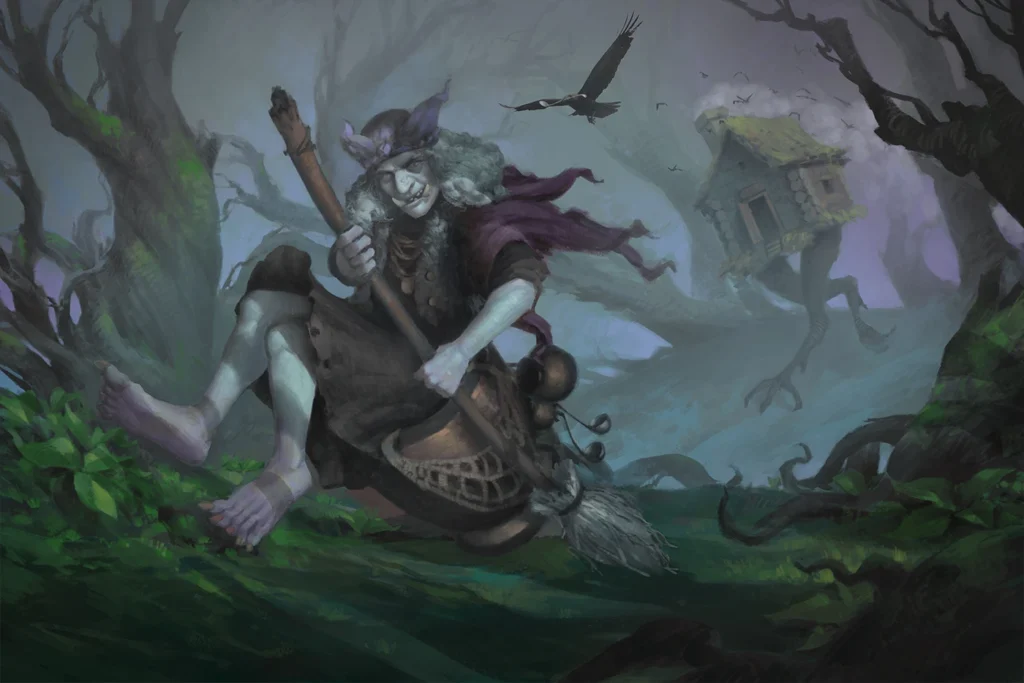
Image credits:deviantart.com
While Baba Yaga originated in ancient Slavic oral legends, she remains a popular and influential character in modern media. Baba Yaga has appeared in many novels, films, video games, and other works of art and pop culture.
She is portrayed variously as a fearsome yet helpful witch, a wild forest spirit, a humorous fairy tale villain, or an icon of feminism and feminine power. Some recent adaptationsNOD seeks to return to the complex, morally ambiguous crone of the original tales. Others present a more sanitized version.
She has been adapted and referenced in various ways that portray her differently or similarly to her original folklore version. Some examples are:
- John Wick: A series of action movies starring Keanu Reeves as a retired assassin who goes on a rampage after his dog is killed by a Russian mobster. He is nicknamed “Baba Yaga” by his enemies who fear him as a legendary killer.
- Hellboy: A comic book series and movie franchise about a paranormal investigator who is a half-demon. He encounters Baba Yaga in several stories where she tries to take his eye or soul as revenge for shooting out her eye in a previous encounter.
- Fables: A comic book series about fairy tale characters who live in a secret community in New York City. Baba Yaga is one of the villains who works for the Adversary, a tyrant who conquered their homelands. She is a powerful witch who can change her appearance and summon her hut.
- Bartok the Magnificent: An animated movie spin-off of Anastasia about a talking bat who goes on an adventure to rescue a kidnapped prince. He meets Baba Yaga who agrees to help him if he answers her riddles correctly.
- Uprooted: A fantasy novel by Naomi Novik about a young woman who is chosen by a wizard to be his apprentice. She learns magic and fights against a corrupted forest that threatens her village. She also meets Baba Yaga who is an old woman who lives in a hut that walks on chicken legs and teaches her some spells.
- Wicked Saints: A fantasy novel by Emily A. Duncan about a girl who can talk to gods and a prince who is a blood mage. They join forces to stop a war between their countries that is manipulated by a dark god. They also encounter Baba Yaga who is a goddess of death and chaos who lives in a hut that flies on wings and has human hands for windows.
- The Bear and the Nightingale: A fantasy novel by Katherine Arden about a girl who can see and talk to spirits of nature and folklore. She lives in medieval Russia where Christianity is spreading and threatening the old ways. She also meets Baba Yaga who is an ancient witch who helps her learn magic and fight against an evil frost-demon.
These adaptations portray Baba Yaga differently or similarly to her original folklore version depending on how they emphasize or change her appearance, personality, powers, roles, motives, etc.
They also reflect or challenge the cultural perceptions and expectations of Baba Yaga depending on how they relate to issues such as gender, identity, morality, spirituality, etc.
FAQs About Baba Yaga
What is the origin of Baba Yaga?
Baba Yaga is a character who likely originated from Slavic pagan beliefs before evolving over centuries of folktales. She may have connections to ancient goddesses, totemic ancestors, female initiators, or shamanic figures who were revered or feared by the Slavic people.
Is Baba Yaga good or evil?
Baba Yaga is portrayed as antagonistic and dangerous in many stories but also helpful toward worthy heroes. She displays morally ambiguous duality, sometimes acting as a donor or a villain or both. She may test, trick, or punish people with riddles, tasks, or threats, but she may also grant wishes, heal diseases, or guard the fountains of the water of life.
Where does Baba Yaga live?
Baba Yaga resides deep in the forest in a magical hut on chicken legs that spins and moves at her command. The hut is surrounded by a fence of human skulls that glow in the dark. She can also fly in a mortar and pestle, which she uses to grind bones and herbs.
What symbols are associated with Baba Yaga?
Some of the common symbols associated with Baba Yaga are skulls, bones, mortar and pestle, broomstick, hut with chicken legs, iron teeth, wild hair. These symbols reflect her nature as a witch, a shapeshifter, a controller of the elements, and a guardian of the underworld.
How do you pronounce Baba Yaga?
Baba Yaga is pronounced baa-buh-yaa-guh.
Conclusion
Baba Yaga stands out as one of the most memorable and uniquely complex characters in traditional Slavic legends. Her mysterious origins, striking imagery, dual symbolism, and central role in folktales has helped her endure as an iconic figure.
Baba Yaga reflects both the dark and light sides of magic, nature, and the human experience. Each generation finds new aspects of meaning in this witch who lives deep in the forest in her moving hut with chicken legs.
Her rich associations will likely continue to inspire many more imaginative adaptations and retellings in the future.
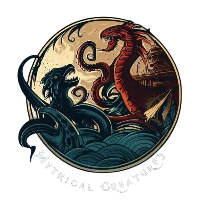
![The Differences Between Skinwalkers and Wendigos[Pics&Facts] 6 mythical creatures art The Differences Between Skinwalkers and Wendigos[Pics&Facts]](https://mythicalcreatures.blog/wp-content/uploads/2023/09/wendigo-vs-skinwalker-what-is-the-difference-768x382.jpg)
